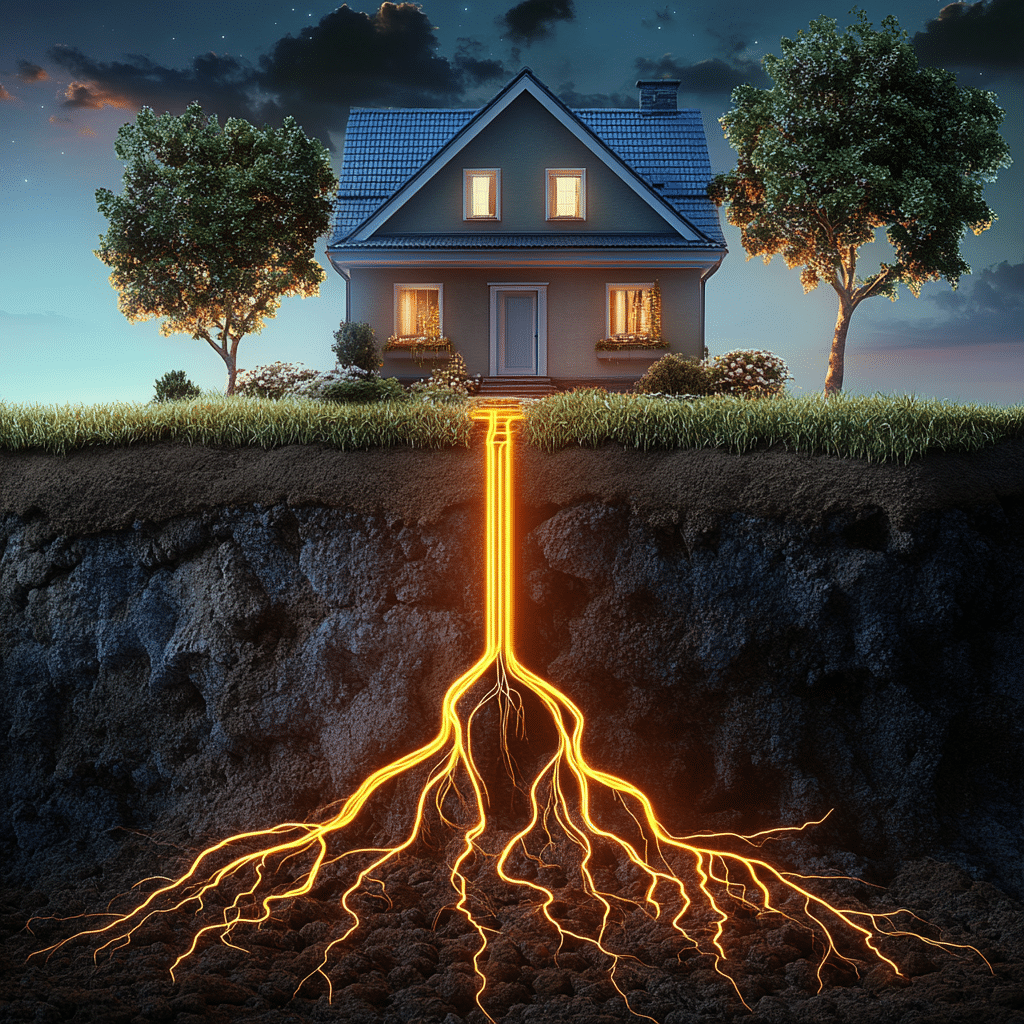
Earthing for a house, also known as electrical grounding, is the process of physically connecting the electrical system of a property to the Earth. This vital connection helps balance the electrical frequencies between a home and the ground, offering significant benefits to personal health and safety from electrical hazards. Earthing your house is comparable to the Earth providing essential energy, much like how the sun delivers vital nutrients.

A home without proper earthing may face serious consequences, including an increased risk of electric shock and potential damage from electric surges. When direct contact with the earth isn’t possible, devices such as special bed sheets and mats can be used for grounding. Earthing has become an essential practice in modern residential properties for its crucial role in maintaining safety and protecting the property against electrical malfunctions.
Key Takeaways
- Earthing, or electrical grounding, is vital for balancing electrical frequencies between a home and the Earth.
- Proper earthing can help prevent electrical hazards, such as shock and damage from electric surges.
- Special bedding and mats can be utilized for grounding when direct connection to the earth is not feasible.
- Home electrical safety is significantly improved through the implementation of an appropriate earth grounding system.
- Understanding how to ground your house is essential for safeguarding your property and its occupants.

Exploring the Fundamentals of Earthing in Residential Properties
Earthing, a fundamental part of residential electrical installations, provides a crucial safety pathway for electrical currents, helping prevent shocks, fires, and other hazards. It allows electrical currents to flow safely to the ground if a fault occurs within the home’s electrical system. The concept of earthing is embedded in the notion that the Earth’s surface contains abundant negative-charged electrical frequencies known as free electrons, which, when physically connected to, provide significant health benefits and protection from various electrical issues in residential spaces.
Understanding the fundamental principles of electrical grounding in homes is essential for maintaining home electrical safety and mitigating potential risks. Below, we discuss some critical aspects of earthing for houses and groundbreaking techniques.
- Grounding Electrode System: This system offers a direct physical connection to the earth, establishing a low resistance route for electrical surges and faults. It typically consists of metal parts buried in the ground, like a grounding rod, plate, or metal pipe.
- Grounding Electrode Conductor: This is a conductor that connects the grounding electrodes to the main bonding jumper, acting as a bridge between the earth and the home’s electrical system.
- Main bonding jumper: A critical component within the electrical panel, it connects the service neutral conductor to the grounding electrode conductor, completing the grounding system.
Different types of grounding techniques exist, providing various levels of protection, depending on the environment and soil conditions. Here are three of the most common techniques:
| Technique | Description | Advantages | Disadvantages |
|---|---|---|---|
| Plate Earthing | A copper or galvanized plate buried in the ground, connected to the conductor. | Lower installation cost; suitable for most soil conditions. | Lower efficiency compared to other techniques; may require regular maintenance. |
| Rod Earthing | A metal rod, typically copper or galvanized steel, buried in the ground and connected to the grounding electrode conductor. | Easy to install; very effective in low soil resistance areas. | Potential for corrosion, requiring periodic inspection and maintenance. |
| Pipe Earthing | A metal pipe, often copper or galvanized steel, buried in the ground and connected to the grounding electrode conductor. | Cost-effective; minimizes corrosion due to increased surface area. | Less effective in high soil resistance areas; may need additional protection. |

Ultimately, a well-designed and properly installed earthing system is integral to a residential property, providing essential protection against electrical hazards and ensuring the safe, efficient functioning of a home’s electrical infrastructure.
The Science Behind Earthing: How It Protects Your Home
Electrical grounding, also known as earthing, plays a vital role in safeguarding residential properties and their residents from potential electrical hazards. By understanding the underlying science and implementing effective grounding techniques, homeowners can provide a secure environment and optimize their electrical systems.
Understanding the Electrical Grounding Concept
The primary function of an electrical grounding system is to provide excess electricity an efficient and safe route from an appliance or wiring system back to the ground, usually via an electrical panel. This rerouted electrical current helps mitigate the risk of fire or electric shock by diverting it from unintended pathways such as metal framing or flammable materials, ultimately protecting both people and property. By utilizing the charged electrical field created by the utility company’s generators, grounding systems ensure that any potential faults are addressed and resolved efficiently
The Role of Earthing in Minimizing Electrical Hazards
A well-designed house grounding system contributes significantly to reducing the risk of electrical hazards within a residential property. This system comprises a network of bare copper wires that direct any stray electrical current—the negative half of the charge—to the ground. By providing a safe path for unwanted electrical energy to follow, earthing helps prevent electrical shocks and fires, serving as a crucial aspect of a home’s safety measures.
Electrical Grounding Techniques: From Theory to Practice
To ensure that electrical currents have a designated path to flow back to the ground, various earthing techniques are employed. These techniques, grounded in scientific principles, are applied in practice by connecting metal plates, rods, or pipes to a home’s electrical system and then to the Earth. Common methods include plate earthing, rod earthing, and pipe earthing, each providing a stable and secure grounding infrastructure.
- Plate Earthing: In this method, a copper plate is buried in the ground to provide a path for excessive electrical charges to dissipate.
- Rod Earthing: A metal rod is driven into the ground, offering an alternative grounding solution in areas with high soil resistance.
- Pipe Earthing: This method replaces a plate or rod with a metal pipe to facilitate an effective connection between a property and the Earth.
By expanding one’s understanding of the science behind earthing and implementing appropriate grounding techniques, homeowners can provide a safer environment in their household, benefiting from the numerous health and safety advantages associated with electrical grounding.
Types of House Grounding Systems: Plate, Rod, and Pipe Earthing
House grounding systems come in various forms to suit different environmental and soil conditions, including plate earthing, rod earthing, and pipe earthing. Each type offers a distinct method to connect residential properties to the Earth, ensuring a reliable grounding infrastructure. Below is a comprehensive summary of the three primary house grounding systems:
- Plate Earthing – Plate earthing involves burying a copper plate in the ground to create an electrical connection with the Earth. This method is commonly employed for residential properties, offering a stable grounding solution in areas with moderate soil resistivity.
- Rod Earthing – Rod earthing uses a metal rod inserted deep into the ground, providing a more effective grounding solution in regions with high soil resistance. It can be useful in mountainous or rocky terrain where direct connections with the soil are difficult to establish.
- Pipe Earthing – Pipe earthing substitutes a plate or rod with a metal pipe buried vertically in the ground. This method is advantageous in certain soil types and moisture conditions, ensuring a secure connection between the home and the Earth.
It is essential to choose the appropriate house grounding system based on various factors such as soil type, environmental conditions, and the availability of materials. More details on these three methods can be found in the comparison table below.
| Earthing Type | Description | Advantages | Disadvantages |
|---|---|---|---|
| Plate Earthing | A copper plate is buried in the ground to establish electrical connection with the Earth. |
|
|
| Rod Earthing | A metal rod is inserted deep into the ground to create a strong electrical connection with the Earth. |
|
|
| Pipe Earthing | A metal pipe is buried vertically in the ground, substituting a plate or rod to establish electrical grounding. |
|
|
Each grounding system has unique characteristics, advantages, and disadvantages, and the selection of the most suitable system depends on the specific conditions and requirements of the property. Regardless of the chosen method, it is essential to install and maintain the house grounding system correctly to ensure optimal performance and safety.
Installing a Grounding Rod: Steps for Ensuring Home Electrical Safety
A comprehensive and effective grounding system is essential for home electrical safety. Installing a grounding rod involves assessing the soil, selecting suitable earthing materials, and following proper grounding techniques. This section provides a step-by-step guide on how to ground your house, ensuring a robust connection to the earth that can protect against potential electrical faults.
Soil Testing and Selection of Suitable Earthing Material
Before installing a grounding rod, it’s crucial to conduct soil testing to determine the soil’s resistivity. Soil type, moisture content, and temperature play significant roles in assessing the conductivity of the ground, which directly impacts the effectiveness of the grounding system.
To ensure a suitable earthing material is chosen, consider the following factors:
- Soil type (clay, loam, sandy, rocky)
- Moisture content
- Ground temperature
Based on these parameters, decide on the most appropriate material for your grounding rod. Common materials include copper, galvanized steel, and other conductive metals.
Connecting Your Home to the Earth: A Step-by-Step Procedure
After selecting the suitable earthing material, follow the steps enumerated below for connecting your home to the earth:
- Dig a pit to enable the burial of the chosen earthing material.
- Place the grounding rod, plate, or pipe within the prepared pit.
- Connect the grounding rod to your home’s electrical installation using a conductor.
- Ensure the grounding resistance meets the required safety standards.
Although the process of grounding a house may seem complex, following these steps and adhering to the appropriate grounding techniques can significantly improve home electrical safety. Remember to consult a professional electrician when installing a grounding rod to reduce any chances of error and to ensure compliance with safety regulations.
Benefits of Earthing Your Home: Enhanced Safety and Equipment Protection
Earthing your home provides multiple advantages that extend beyond safeguarding against electrical hazards. When a grounding system is correctly installed, a multitude of benefits can be reaped:
- Protection from electrical shocks
- Prevention of electrical fires
- Resistance to damage from lightning strikes or power surges
- Improved overall power quality through reduced electrical noise and interference
- Extended lifespan and better performance of electrical equipment
These benefits contribute to a secure and efficient household electrical system, ensuring the safety and wellbeing of your home’s residents and protecting your valuable appliances against potential damage.
Reduced Risk of Electrical Hazards: A Safer Home Environment
One of the most prominent benefits of earthing is the protection it offers against electrical hazards. A properly grounded home vastly reduces the risk of electrical shocks, contributing to a safer environment for you and your family. Furthermore, earthing minimizes the chances of electrical fires by providing a direct path for stray currents to flow back into the ground, helping to prevent overheating and ignition of flammable materials.
Protection for Electrical Equipment: Prolonged Lifespan and Enhanced Performance
Grounding for house electrical systems not only ensures safety but also grants added protection for your appliances. By providing a safe discharge route for excess electric charges, the grounding system helps reduce electrical noise and interference, which can negatively impact your equipment’s performance and lead to premature wear and tear.
Furthermore, the effective grounding of electrical devices combats potential damage from unexpected voltage spikes, such as those caused by lightning strikes or power surges. This attention to detail ultimately contributes to a longer lifespan for your appliances, saving you money on repair and replacement costs over time.
In conclusion, the benefits of earthing cannot be overstated. By grounding your home, you not only create a safer living environment but also protect your valuable electrical equipment and ensure optimal performance of your household electrical system. With the advantages of reduced electrical hazards and safeguarded appliances, investing in a proper grounding system is an essential component in maintaining a secure and efficient home.
Grounding for EMF Protection: Understanding Its Efficacy
Grounding a house serves as an effective measure against electromagnetic fields (EMFs), providing a safe discharge point for excessive electrical charges that can accumulate due to internal circuitry interference. By preventing the buildup of static electricity and the effects of EMFs on the body’s electrical systems, earthing contributes to overall wellbeing and can alleviate various symptoms associated with electrical hypersensitivity.
Electrical grounding plays a crucial role in earthing benefits, as it creates a direct connection between the home’s wiring system and the Earth’s surface. This connection allows for the safe dissipation of electrical energy, reducing the exposure to harmful EMFs and minimizing their impact on occupants’ health.
EMF exposure has been linked to several adverse health effects, including:
- Sleep disturbances
- Headaches and migraines
- Chronic fatigue
- Mood disorders
- Memory and concentration problems
Implementing grounding for EMF protection in a residential property ensures that individuals within the household experience a reduction in exposure to EMFs and, consequently, a decrease in the aforementioned symptoms.
Moreover, incorporating proper electrical grounding in a home can help reduce overall EMF levels by:
- Eliminating voltage fluctuations and stabilizing the electrical system
- Shielding electronic devices and appliances from high-frequency interference
- Providing a pathway for EMFs to be discharged into the Earth, minimizing their impact on the living environment
In summary, grounding for EMF protection offers an efficient solution for mitigating the harmful effects of electromagnetic fields in residential properties by creating a safer, more stable electrical environment. By implementing electrical grounding techniques and ensuring proper maintenance, homeowners can safeguard their living spaces and contribute to the overall health and wellbeing of all inhabitants.
Ensuring Proper Grounding: Maintenance and Troubleshooting Tips
Maintaining the earthing system of a house is crucial for ongoing home electrical safety and optimal performance of the electrical setup. Regular inspections and testing of earthing resistance ensure that the system adheres to required standards. Checking connections, inspecting for signs of corrosion, and making sure that the grounding path remains unobstructed are vital for an efficient grounding system.
Troubleshooting involves specific steps to identify and address issues within the grounding infrastructure. Noticing changes in earthing resistance or experiencing electrical shocks may indicate a problem with the system. Promptly addressing these issues is crucial to securing the integrity and safety of the grounding system. Remember to consult a licensed electrician for proper assessment and rectification of any grounding maintenance concerns.
Be proactive in ensuring the safety and efficacy of your home’s earthing system. By following regular maintenance practices and employing effective troubleshooting grounding issues when needed, you can enjoy the numerous benefits of proper electrical grounding while safeguarding your property and loved ones from potential electrical hazards.
FAQ
What is the purpose of earthing for a house?
Earthing for a house, also known as electrical grounding, is the process of connecting a home’s electrical system to the Earth. This connection helps to balance electrical frequencies and provides protection against electrical hazards, such as shocks and fires. It also offers numerous health benefits and improved efficiency for your home’s electrical devices.
What are the different types of house grounding systems?
There are several types of house grounding systems, including plate, rod, and pipe earthing. Each type is designed to suit a variety of environmental and soil conditions. Plate earthing uses a copper plate buried in the ground, rod earthing utilizes a metal rod, and pipe earthing replaces the plate or rod with a metal pipe.
How do I install a grounding rod for my house?
A grounding rod installation begins with conducting a soil test to determine the soil’s resistivity. Based on those results, you can choose the appropriate earthing material, such as copper or galvanized steel. After digging a pit and burying the chosen earthing material, the grounding rod is connected to the home’s electrical installation using a conductor. Finally, the entire installation is tested to ensure it meets required safety standards.
What are the benefits of earthing in residential properties?
Earthing provides several significant benefits, including protection from electrical hazards like shocks, fires, and lightning strikes, improved power quality, and increased lifespan of electrical appliances. Earthing also mitigates the impact of electromagnetic fields (EMFs), which can contribute to overall wellbeing and alleviate symptoms of electrical hypersensitivity.
How do I maintain and troubleshoot my home’s grounding system?
Regular inspections, testing of earthing resistance, and checking connections ensure that your home’s grounding system adheres to required standards. Look for signs of corrosion and ensure that the grounding path remains unobstructed. If you encounter issues like increased earthing resistance or electrical shocks, address them promptly to secure the grounding system’s integrity.
What role does earthing play in EMF protection?
Grounding for EMF protection prevents the buildup of static electricity and mitigates the effects of EMFs on the body’s electrical systems. By connecting your home to the Earth, you help counteract excessive electrical charges that accumulate due to internal circuitry interference. This enhances your overall wellbeing while minimizing the risks associated with electrical hypersensitivity.



